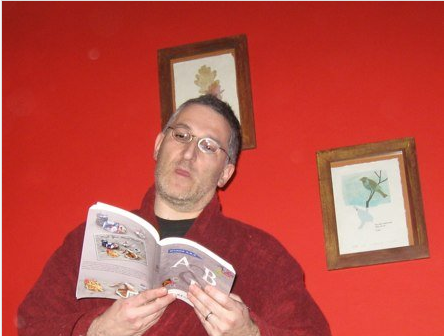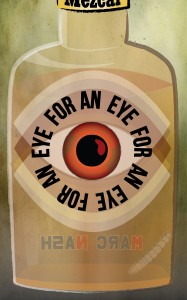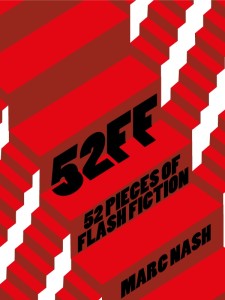Interview – Literary and Flash Fiction author, Marc Nash
Self-Publisher’s Showcase: Today we are joined by Marc Nash, author of AN EYE FOR AN EYE FOR AN EYE, and amongst other things, 3 books of Flash Fiction. Welcome to the Showcase Lounge, Marc. Please do make yourself comfortable, we’ll go grab some refreshments.
Marc Nash: Thank you very much for having me SPS. Incidentally that’s the same acronym as what I got my laughable degree in, “Social And Political Sciences”, but let us never mention this again.
SPS: Can we kick off today by just asking you to tell our readers a little about yourself?
MN: Born and bred in London, spent most of my adult life in the regressed adult world of independent music. In the last 5 years I have worked for an NGO in the freedom of expression world, so both jobs have supported both my independent approach to my art and the emphasis on not censoring myself for fear that it’s not commercial. I started writing at university because I was on the point of dropping out, when they opened a new theatre and I wrote plays to express my general dissatisfaction with the world and politics. I only switched from stage plays to writing prose when my twin boys came along and I couldn’t hang around theatre bars any more. I have managed their junior football team off and on for 6 years, which has caused me more sleepless nights than anything to do with literature.
SPS: Prior to writing Flash Fiction and novels you worked in the Indie music scene. Are there any lessons you learned there that have helped you in your writing?
MN: Just an attitude of mind to experiment and not be influenced by the prevailing market trends. I worked there for so long, I saw the same music trends come round for a second or third time. There is very little art that is genuinely new in this day and age.
SPS: An Eye for an Eye for an Eye is wonderfully described as a dystopian police procedural novel with paranormal elements. Where did the inspiration come from?
MN: Um a rather negative one I’m afraid. I’d been following the online debate about how China Mieville should be nominated for the serious literary prizes but is overlooked because he writes genre. So I started reading him to find out what I thought. And although I love a book like “Embassytown”, I hated his book “Kraken”. I finished it on a Sunday very annoyed by it and woke up on Monday with the idea for a novel that would determinedly be both literary and genre. it just so happened to be the first week of November, so although I didn’t formally participate in NaNoWriMo, I was shadowing it. Normally when I write a novel, it has to seethe away in my subconscious for 6 months. This one came out virtually fully-formed, fuelled as I say by irritation with “Kraken”. Some of the themes must have be floating around my head, but to be pulled together into a coherent plot so quickly was a new experience for me.
SPS: Tell us about Simon Moralee. It can’t have been an easiest way for someone to discover they have a gift, how does it affect him?
MN: Well he has a gift which may just turn out to be a curse, that of being able to recover the last few frames a person sees before they die, which in a society full of murder victims makes him a very valuable commodity to law enforcement and detection. But it’s a burden he struggles to bear, plus he is forever trying to understand where it originates from and the novel explores with him the psychological roots from which it may derive, less a gift, and more a form of delusory self-protection. At age 18, he is cradling the body of his murdered mother and in doing so has revealed to him the face of her killer. It isn’t a stranger, so perhaps it’s also bound up with his guilt that he should have seen it coming and perhaps preventing her murder. Such a trauma could be utterly overwhelming psychically, but maybe it gets channelled into the form of his power.
SPS: Simon is unable to keep pace in the murders as society loses hope? Do you feel society losing hope is something that is true outside of your novel?
MN: Gosh this is a big topic. Well there’s no doubt to my mind that people are increasingly alienated from the political classes claiming to represent them. But I would hope my exploration is a bit more analytical than Russell Brand’s recent outpourings on the subject. I look at the question of what happens when a State cuts away more and more benefits and minimum welfare requirements from its citizens, at what point do the citizens adjudge there is no reason for them to remain aligned to the State any longer? When people are cut adrift of society, or cut themselves adrift, then they exhibit different behaviour from when they are committed to that society. Cormac McCarthy’s “The Road” suggested a predatory survival of the strongest world, whereas my book shows it to be more desultory, as without hope people can’t even raise the energy to be systematically ruthless and self-serving.
SPS: What feelings would you like the novel to evoke, do you want to get a particular message across or do you prefer it to be a unique experience for everyone to take away what they will?
MN: I would never tell the reader what they may or may not feel and experience. I am constantly surprised and thrilled by readers giving me their ‘read’ of my own book. When I read live, in the rehearsing of the pieces I always find new things that I didn’t even know had been buried in the words.
SPS: How do you find writing novels compared to your Flash Fiction work? Do you approach it differently?
MN: Well flash pieces are much more spontaneous. Once I get the central idea or image, I will sit down to write it straight away and often it needs little editing. With a novel however as I mentioned, once I get the central image or idea, I will let it sit working away in my head for about 6 months without doing anything except perhaps make the odd note. I certainly won’t try and write any of it out within that 6 months period. But at the end of it, it’s ready to emerge and I can normally write that first draft complete in about a month. Then comes the hard work of editing it and making it work.
SPS: How do you find the task of getting your story told in under 1000 words? Do you find you trust more in the reader to interpret the unsaid?
MN: Well through flash fiction’s word limit, I have discovered an entirely different way of structuring narrative. You don’t have time to establish the mood or the world of the story, you plunge right in. This isn’t beginning, middle, end of the classical story. For me it’s more akin to looking at a gem and moving it in the light to show all its different facets. So I’ll take a theme or image and keep moving it a little to reveal a new meaning or way of looking at it, so hopefully the reader is actually getting more rather than less to digest, albeit on a quite small area under scrutiny
SPS: In 52FF, 16FF and Long Stories Short, you have produced 3 collections of Flash Fiction. Do you feel that your writing style evolved over the 3 books?
MN: That’s an interesting one. They are different one from another, but I’m not sure it represents any evolution in me. “52FF” was the first of the three and that had the last 5 stories as really experimental pieces, so that thread exists in all three. I suppose ‘Long Stories Short” was the one most rigorously presenting stories that weren’t just beginnings, middle, ends, even having a story called “A Series Of False Endings” which is a story made up entirely of endings. But the weird thing about that story was I wrote it a couple of days after I published “16FF” (the middle collection) and it could have appeared in that one if I’d just waited a couple of weeks. I performed it along with stories from “16FF” and it fitted in seamlessly.
SPS: They appear as unrelated short stories in each collection, are there any underlying themes present in the books?
MN: Language and its limitations and the mutability of the image underlies many. When I try and work out the order the stories should appear in any one collection, I do try and group them by theme and make sure they’re separated out within the book. But as to a theme unique to any collection, no that’s probably not the case.
SPS: Do you find any positives/constraints to writing in the short form?
MN: Innumerable ones as mentioned above. You can carry off a concept over the length of 1000 words you could never pull off over the length of a novel without the reader getting fed up with it. I’m most excited by the challenge of trying to bring the different narrative structures to longer works. That is an ongoing process. I think the narrative structure of my novel “Time After Time” is pretty interesting in this respect.
SPS: Do you have plans to continue to switch between longer and shorter forms for the foreseeable future?
MN: Well that’s up to the stories themselves! Any piece of work recommends its natural length to me and I have to abide by that. I have about 15 flashes written since the last collection. I guess when I have enough I’ll bring out another collection. But I’m not writing them as regularly as I have in the past, only when they come to me, as against me sitting down determinedly to write one a week.
SPS: You love to experiment with different visual ways to tell your stories, can you tell us how this all came about?
MN: I only started to write because the novels I wanted to read weren’t really out there in any great number. So I decided to write them and being self-taught I was pretty much making up the rules and then breaking them as I went along. A big part of that is to do with language, I wanted to drill down to the DNA level of the alphabet (and etymology) and that involves typography and the layout on the page. Some of my stuff can’t be published on Kindle because of its format being limited to block print. But hopefully that will come in time.
SPS: Do you have a favourite visual piece that you’ve done that we can share with our readers?
MN: This is called “Just Aphasia Going Through”. It actually uses the concept of the kinetic typography to not only move words on a screen but to mutate them into other words. That is the medium and the words supplement each other to bring out new meanings, rather than one just serving the other as a nice way of presenting them. It was through reading the piece live that I realised there was a better way of bringing out the mutations of the words from one into another and that was to do it visually.
SPS: Actually, now would be a good time to ask; what can we expect in the near future from the pen (or fingers) of Marc Nash
MN: Well I’m please to report that a second kinetic typography rendering of one of my flash pieces has entered production and will be out in the new year. But I’m also excited by a digital project which is a book the reader will plot their own way through. This isn’t one of those treasure hunt books, but more about the reader questioning things in their own world through the possibilities offered in the narrative; it’s about our knowledge of the physical world and how the observer can distort what they observe. There’s also a graphic novel that is fully storyboarded and just needs a push to find an illustrator. It’s very dark, which is why I would want the colour scheme to be pastel shades; except for the human organs that appear throughout…
SPS: Was the Self-Published/Indie-Published route always your preferred route for your work?
MN: It was complete happenstance. I got into conversation with the head of one of the early POD companies and as I was talking to him just thought to myself why on earth am I still waiting for something to happen with my literary career? Without that conversation I may never have started the journey. Complete chance. I’m not even sure how I ended up talking to him in the first place.
SPS: If you could give one piece of advice for someone looking to get into writing, what would it be?
MN: You will get a lot of advice in this business, some of it contradictory. So how are you supposed to know which is right? Just stick to your own artistic vision and trust to your own judgements and that should be your ultimate guide.
SPS: Before we bring this interview to a close, it’s your chance to name-drop. Anyone who you feel is deserving of more recognition at present or someone whose writing you have recently enjoyed? Now is your chance to spread the word…
MN: Quite a few, Alison Wells, Vivienne Tuffnell, Penny Goring, KD Rose, you already know Kneel Downe. Dan Holloway is a really interesting writer always trying to do new things with literature, he wrote a novel without words but numbers instead. Check it out!
SPS: Thank you for joining us today Marc, and good luck in the future.
MN: Thanks for the opportunity. Without this sounding too crawly, this has been the most incisive set of questions I’ve ever been offered in interview and so really appreciate the care and thrust behind them.
SPS: For more information on Marc Nash and his work please do visit his Author page where you can pick up a copy of An Eye For An Eye For An Eye and all of Marc’s previous work.
















Leave a Reply